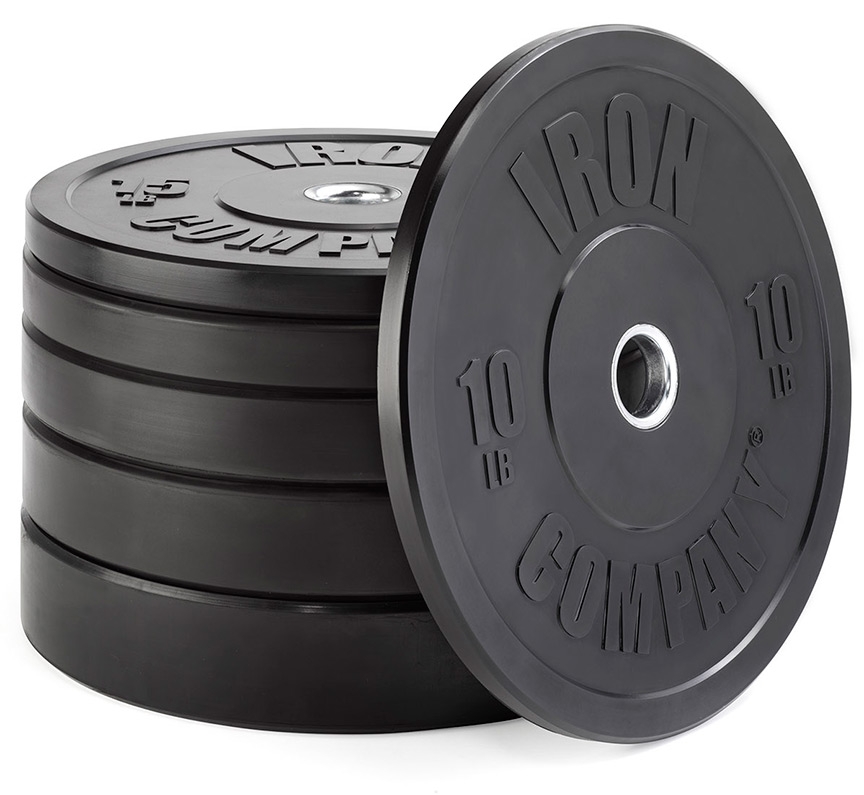
Rubber Bumper Plates Buying Guide
Rubber Bumper Plates Buying Guide
You may have received your first barbell or weight set as a child or a teenager. It may have been the plastic-coated cement type sold at a supercenter, not the clanking, noisy, steel ones the big guys use at the gym. With grizzle and much fortitude, you graduated from plastic and moved to steel to become one of those muscular monsters hoisting vast poundage that would make even superheroes weep. But training with rubber bumper plates may actually be the next step to peak performance and breaking personal records.
Rubber bumper plates (also called bumpers) may have a very distant family resemblance to that first set of beginner weights made of cement and coated in hard plastic. But don't be fooled. Rubber bumper plates are Olympic plates made of hard rubber with steel inserts so that CrossFitters and powerlifters can drop loaded bars without damaging floors of gyms or the weights themselves.

IRON COMPANY rubber bumper plates are made of premium virgin rubber and are absolute necessities for home gyms, garage gyms, gym weight rooms or CrossFit boxes. The plates' dense rubber formulation makes them fit on Olympic bars snugly with anchored inserts that eliminate loosening and slipping which are built of heavy-gauge steel with shiny zinc plating.
Why Rubber Bumper Plates?
Rubber bumper plates enable lifters to do the serious, Olympic-style lifts, including snatches and clean and jerks. Compared to conventional iron weight plates, bumper plates reduce the torque and stress on barbells and damage to gym floors, and significantly reduce the chance of injury caused by several hundred pounds dropping from a height of five to eight feet.
Besides safety and less potential damage to gym floors and the weights, using bumper plates has a pleasant and less obvious benefit too. Rubber bumper plates, unlike their steel cousins, will not flake, chip and rust like the undercarriage of your truck. This means that in exceptionally humid areas, or if taking them outside for a WOD, your bumpers will maintain their aesthetics and will not corrode from the elements.
What's the main difference between steel plates and bumper plates? Rubber bumper plates bounce as opposed to coming to a thundering, earth-shaking stop. For lifters trying to break a PR (personal record), that's important. Too many steel-to-cement-floor collisions might either get your gym membership revoked or send you to the local home supply store for material to do floor repair.
Training with bumper plates is done the same way as conventional or steel weight plates - with a few minor exceptions. Bumper plates may allow you to spend more time on the big three (the squat, the bench press and the deadlift) without having to worry so much about structural damage.
Training with rubber bumper plates also allows you to test your true caliber with the mother of all power-lifting moves, the clean and jerk.
Bumping Along
We at the Iron Company know all about the human strength potential. Our strength training equipment delivers the power to send you on your way to demolishing your PRs.
Our exercise platforms encompass the entire spectrum of building the human machine with power cages, power racks and a hub of heavy movers for squats, bench presses, shoulder presses and deadlifts.

About the Author
Jayson Operio’s certifications include: NASM CPT - National Academy of Sports Medicine - Certified Personal Trainer, ACIM CPT - American College of Integrative Medicine - Certified Personal Fitness Trainer and PEX CPT - APEX Fitness Group - 24/5 Complete Personal Trainer. Jayson previously was a personal trainer with 24 Hour Fitness, guiding clients to achieve their fitness and sport performance goals. He has almost twenty years of combined fitness industry sales experience with previous companies Busy Body Home Fitness, Precor Home Fitness, Polar Electro, and currently IRON COMPANY. His passion for fitness was set as a foundation at an early age. With his father in the military, push-ups, pull-ups, sit-ups, and running a couple of miles were the norm. It was cross training for physical fitness. Fast forward, and now with over fifteen years in the fitness industry, he has gained experience and knowledge about various products and training techniques, and how they can be utilized to better one's fitness level and/or sport performance. His personal performance goals to run faster, jump higher, cycle longer, and press heavier have influenced his commitment to find fitness solutions. Knowing how the right equipment with proper technique can lead to results first hand, he’s here to share my knowledge with others to find the right products at a great price. Contact Jayson here.


